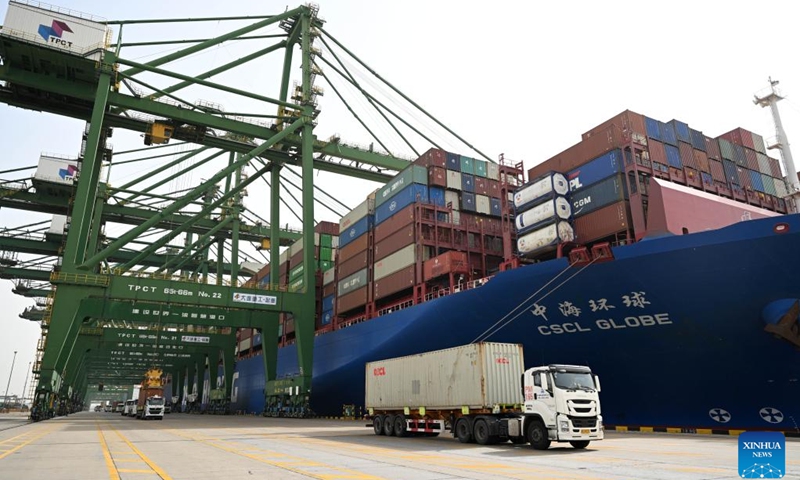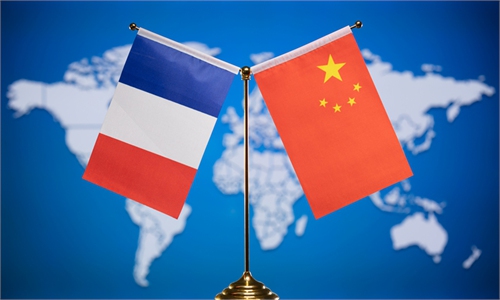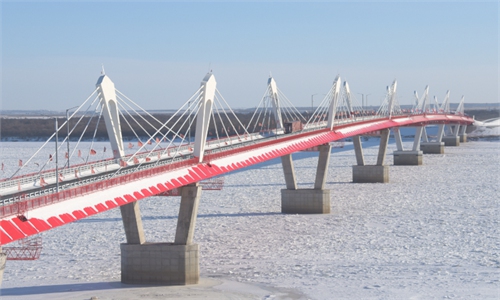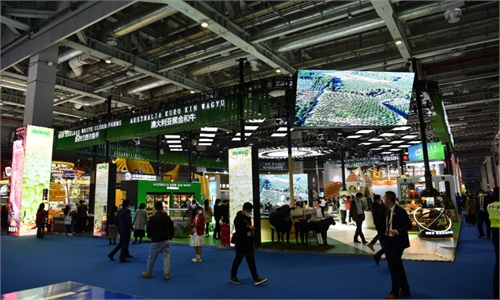China’s March exports surge 23.4% y-o-y, ‘a pleasant surprise’
Nation ‘locomotive’ for
global economy amid US-led decoupling: expert

Containers are transported by trucks at the Pacific international container terminal of Tianjin Port in north China's Tianjin, April 11, 2023. North China's Tianjin Port handled approximately 5.047 million twenty-foot equivalent units (TEUs) of containers in the first three months of 2023, up 9.09 percent year on year.(Photo: Xinhua)
China's export volume grew by 23.4 percent year-on-year in yuan-denominated terms in March, which is seen by analysts as a "very pleasant surprise" amid the current complex and volatile international business environment, and underscores the resilience of the Chinese economy.
They said China will become a locomotive for global economy to return to development track from negative impacts of COVID-19, US-led unilateralism and protectionism as well as other risks, dealing a heavy blow to certain Western countries' decoupling push.
China's export volume in March stood at 2.15 trillion yuan ($312.85 billion), up 23.4 percent from the previous year, while soaring 48.4 percent month-on-month, according to data released by the General Administration of Customs (GAC) on Thursday.
In US dollar-denominated terms, March exports jumped 14.8 percent year-on-year.
"The high-speed growth rate of China's export is totally unexpected, which is a very pleasant surprise," Cao Heping, an economist at Peking University, told the Global Times on Thursday.
"The unexpected export growth demonstrates that the US-led decoupling push or geopolitical tensions couldn't reduce Western reliance on Chinese products. Chinese people have blazed a new path of supplying the world with high-tech, high-quality products," Cao said.
In the first three months of 2023, the exports of electric vehicles, lithium batteries and solar cells increased 66.9 percent year-on-year, driving up the country's overall exports by 2 percentage points, according to GAC data.
Foreign trade by private firms maintained fast growth in the first quarter, jumping 14.4 percent year-on-year to 5.18 trillion yuan, accounting for 52.4 percent of the total trade volume.
Imports and exports in the country's less-developed central and western regions grew by 12.6 percent year-on-year in Q1 to hit a record high of 1.84 trillion yuan.
In Q1, the Association of Southeast Asian Nations (ASEAN) remained China's largest trading partner with a trade volume of 1.56 trillion yuan, up 16.1 percent year-on-year. Foreign trade with the EU - China's second-largest trading partner - inched up 2 percent to 1.34 trillion yuan. Trade between China and the US fell 6.2 percent year-on-year to 1.11 trillion yuan, GAC data shows.
In the same period, China's trade with the Belt and Road Initiative (BRI) partners grew by 16.8 percent year-on-year, and that with other RCEP members increased 7.3 percent year-on-year.
Due to drop in international commodity prices, such as fuels, iron ore and agricultural products resulting from the US interest rate hike, China's import volume extended drop trend in March, falling 1.4 percent year-on-year to $227.4 billion in dollar-denominated terms. However, the country's March import still increased 15.3 percent from February "due to continuous rise in China's domestic demand," analysts said.
Locomotive for global economy
China's imports and exports showed strong resilience in the first quarter, registering a stable performance with good momentum for growth, which set a stable foundation for the quality growth of the country's foreign trade sector for 2023, Lü Daliang, spokesperson of the GAC, said at a press briefing on Thursday.
Zhu Qiucheng, CEO of Ningbo New Oriental Electric Industrial Development, expressed confidence that the country's foreign trade will show further recovery in the second half of 2023. The company's export orders have been arranged till September 2023.
The fundamentals of the Chinese economy and the country's foreign trade remain robust, Zhu said. "Its Western media's wishful thinking to render China's foreign trade sector weak by hyping industrial chain shift."
Zhu noted a consensus among Chinese exporters that "we should climb up to the high end of the global value chain and contribute to the high-quality growth of China's foreign trade sector through technological advance."
Zhou Maohua, an economist at Everbright Bank told the Global Times on Thursday that China's foreign trade development still faces pressure and mounting challenges this year, as geopolitical tensions continue to disrupt global industrial and supply chains while the US and the EU face potential economic recessions.
Zhou forecasted that China's overall foreign trade will grow at a "moderate rate" this year on the back of continuous optimization of the country's foreign trade structure and stable growth in new energy products.
"China's domestic economic recovery, along with positive fiscal policies to stimulate consumption and the rebound of the real estate sector will boost imports of goods and services," Zhou said.
Since the adjustment of its COVID response, China has stepped up efforts to resume on-site economic activities in order to bolster economic growth. The 133rd Canton Fair is scheduled to kick off in Guangzhou, South China's Guangdong Province, on Saturday, with tens of thousands of participants from over 220 countries and regions.
"Given the ultra-strong performance of the country's exports, its factory output should also be better than earlier forecast, which may together drive the national GDP growth up to 4.5 percent year-on-year," Tian Yun, a veteran economist based in Beijing, told the Global Times on Thursday.
The National Bureau of Statistics will release key economic figures on Tuesday, including GDP growth, industrial output, fixed-asset investment and retail sales.
Tian said international institutions like the IMF may further revise their economic forecast for China in 2023 to 5.5 percent from the current projection of 5.2 percent.
"China will be a locomotive for global economy this year, injecting stability and growth momentum to the world that has been suffering from pains caused by US-led unilateralism and protectionism as well as the Ukraine crisis," said Cao Heping from Peking University.



